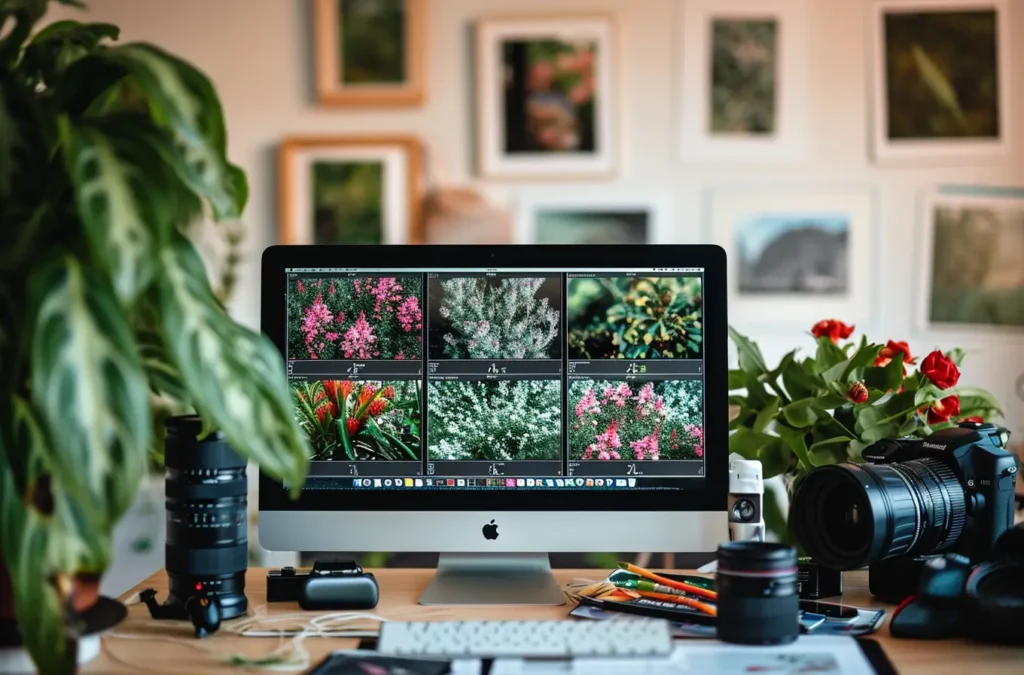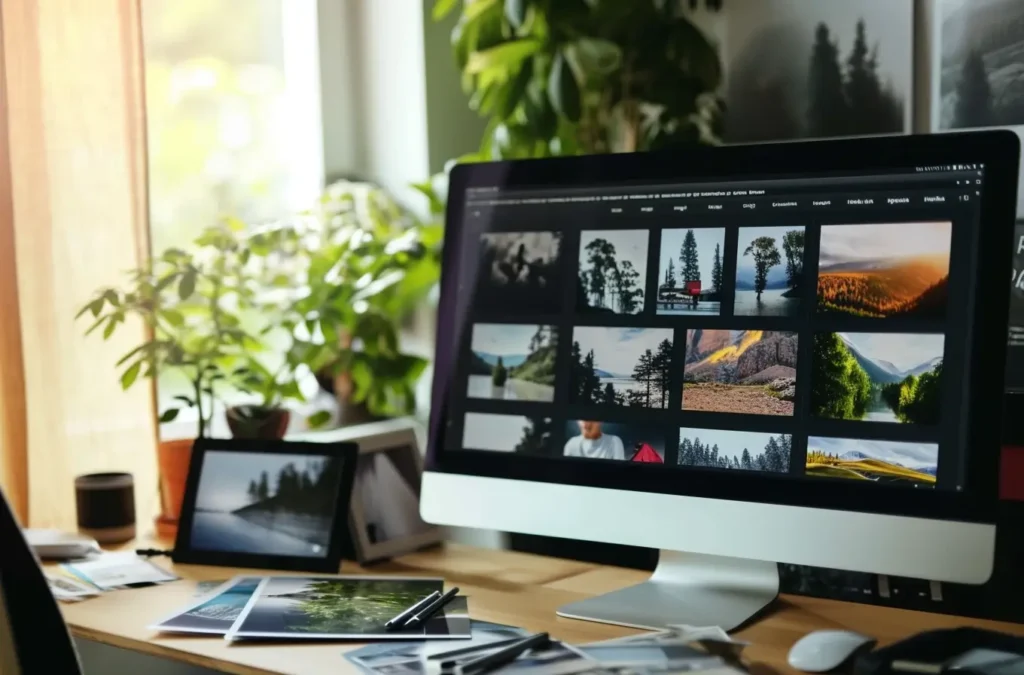Table of Contents
Introduction
Have you ever captured a stunning moment that you couldn’t wait to share with the world? How about making your love of photography into a successful online business?
The transformation → Starting a blog — a photography blog.
Launching a photography blog could catalyze the change you’ve been waiting for. Whether you’re a photo buff, small company owner, camera fan, or hobbyist excited about using your lens to attract new customers and make additional money, you’re in the perfect place.
This guidance on starting a photography blog will be your key to success, helping you build a name for yourself in photography. Based on three aspects: tech, content, and visual, gear up to make your journey into the blogosphere a rewarding and fulfilling adventure.
Why are we so sure about the success of a photography blog?
| 3 Big Reasons | ||
|---|---|---|
| Statistical Data | Real-World Examples | Our Experience Speaks |
| Most people really like checking out pictures and info online. And around 86 out of 100 people among these prefer looking at online portfolios. This is a big deal because having a photography blog can make a real difference. In our exposure, businesses with blogs get 97% more links, like having more signposts to their work online. This is not just a random fact – it means that having a blog can make it much easier for people to find you online. | Our experts have revealed some essential numbers. They say having a blog helps you become an expert in your field. This is not just something we speak about; it’s proven by successful photography blogs like Digital Photography School, Modern Market, and Handcraft Films, which have made a good amount of money, from $30,000 to $60,000. | Launching a photography blog is about more than just putting up pictures. From what we’ve seen, having a blog isn’t just about showing off your work; it’s about making the content work for you on the internet and networking connections that can turn into money. Learn More → What is the purpose of blogging for business. |

Why Should You Start a Photography Blog?
So, is a blog worth it? Here are a few more overarching explanations of why you should do blogging photography.
| Reasons | Description |
|---|---|
| Online Portfolio and Expertise Display | Showcase skills, versatility, and deep knowledge through a digital portfolio. |
| Client Magnet and Trust Building | Attracts potential clients, builds trust, and increases chances of securing photography gigs. |
| Engagement and Return Visitors | Maintains audience engagement with regular, visual-led content, encouraging return visits. |
| Attracting a Wider Audience | Tailors content to appeal to existing and potential clients, expanding reach. |
| Establishing Subject Matter Expertise | Positions as an expert with educational content, ideal for those aspiring to teach photography. |
| Improving Search Engine Ranking | Enhances SEO by maintaining a well-curated blog, making work more discoverable on platforms. |
| Additional Revenue Streams | Explores diverse income sources, like sponsored content, for added revenue and business growth. Learn → How Fast Can you Make Money Blogging? |
Things to Consider Before Starting Your Photo Blog
Starting your photography blog can be exciting. Traveling to cool places and capturing awesome photos is fantastic, but planning carefully is essential. Before jumping into photo blogging, there are some important things to consider to ensure a successful and enjoyable experience.
Let’s delve into their details and importance ratio.
| Requirements | Details | Level (=100%) |
|---|---|---|
| Blogging Mind | This involves understanding the commitment, consistency, and creativity required to maintain an engaging and informative platform. | 15% |
| Define Your Target Audience and Niche | Whether you’re catering to photography enthusiasts, beginners, or a specific genre of photography, identifying your audience will guide your content creation. | 12% |
| Choose a Unique and Memorable Blog Name | Your blog’s name is your digital identity. Pick a name that reflects your style and resonates with your target audience. | 15% |
| Equipment | Investing in the right equipment is pivotal for a successful photography blog. Ensure you have a reliable laptop, computer, and, most importantly, a high-quality camera and lenses. | 12% |
| Time Commitment and Consistency | Blogging demands time and consistency. Our experts advise starting with a realistic posting frequency that aligns with your available time and gradually increasing as your blog gains attraction. | 12% |
| Research Legal and Copyright Considerations | Understanding the legal aspects of using images or photos you plan to use on your blog is crucial to avoid any penalties. | 12% |
| Know Your Competitors | Familiarize yourself with other photography blogs in your niche. As per our guidance, follow the below tips: analyze their content, engagement strategies, and audience interaction. | 12% |
| Optional | Consider additional elements like shooting locations, photo editing software, and the possibility of a home studio. | 10% |
But wait, do people still read blogs? Find your answer here.
How To Start A Photography Blog: 10 Simple Steps for Beginners
Let’s follow the steps to set it up.
1. Choose Your Niche
First things first, nail down the perfect niche. We advise choosing a niche based on the following factors:
- Choose a niche that aligns with your interests and passions. This will keep you engaged and prevent burnout.
- While your passion is critical, consider the one with enough audience interest. Blend what you love with what people want to read. This way, you will follow your passion step by step and enjoy your blogging journey, too.
Okay, now some hard work demanded is next. As the way we helped our clients launch their photography blogs, we also suggest you validate your blog niche meticulously. You ask how?
- Conduct comprehensive research to gauge niche size using tools like Google Trends, ensuring a substantial audience for long-term engagement and growth.
- Analyze competitors within your picked niche. Study their websites for content inspiration, writing style, and potential improvements. Additionally, identify and take advantage of their mistakes to carve a unique space, setting the foundation for long-term success and profitability.
Here Are Some Niche Ideas To Get You Going.
- Travel Photography Blog
- Food Photography Blog
- Fashion Photography Blog
- Lifestyle Photography Blog
- Nature Photography Blog
- Tech equipment Photography and reviews blog.
You see, the options are endless; therefore, select the one that matches your passion and all the exciting topics before you choose.
2. Choose a Blogging Platform
Now, the big question is – which platform to choose? There’s a sea of options, from freebies like Wix and WordPress.com to paid ones. But let us spill the beans – steer clear of the freebies. We tried them, and trust us, they come with headaches. They offer poor customization, not-so-professional vibes, and fewer monetization possibilities, and the worst part is your account can be deleted without warning.
So where to go?
The good news is here. The best platform option is WordPress, but not the free WordPress.com; it’s the self-hosted paid version from WordPress.org. This gem powers a third of the internet; we love it for several reasons, and that’s why we use and recommend it to all our bloggers for its reliability, versatility, and endless possibilities.
- You don’t need to be a tech expert.
- It is easy to use.
- You can make your blog look awesome without stress.
- Customize it like your playground, add ads easily, and choose from many themes.
- Making money is easy.
And the most remarkable thing? You get to run your blog on your very own web address. It means you’re the boss and have complete control. You can create a photography website, portfolio, booking form, sales gallery, and other cool features. It’s all in your hands.
3. Pick a Domain Name and Register It
Now comes the most essential step – deciding over your domain name. Your domain is the unique name that defines your website – it’s what people type into Google to find your blog. Therefore, choosing the right name is paramount because it becomes your identity and brand on the web.
Expert’s Advice
As search engine optimizers and a professional branding agency, we strongly advise taking your time with this decision. Don’t rush it. Since your domain will stick with you as long as you continue for a very long time, it is highly recommended that you choose wisely.
Here’s a pro tip: pick a domain name that relates to the subject you will be writing about. This could be photography or something more focused, recognizable, and simple to recall. Note that the more interesting, the more significant the impact.
Here are some clues to help you craft a great domain name:
- If it’s an international domain, make your blog accessible worldwide. No worries about changing it if you move.
- Don’t box yourself with a particular domain; keep it broad to cover various topics.
- Add a word at the beginning or end to make it unique.
- Say no to hyphens and numbers. These confuse people and make your domain harder to remember.
- Choose a name that allows your brand to grow.
Some Examples of Domain Names

Okay, so here are some excellent photography blog names:
- HappyPhotography
- LensShot
- PixelWorld
- PhotoUp
- SnapTreats
Need more ideas? Try Word Mixer for some creative combinations.
The Next Step?
After choosing a name, see if it is available. Then, walk over to reputable domain registrars and register it. Our top recommendation here is BlueHost, which offers a wide range of domain extensions, competitive pricing, a user-friendly interface, domain registration, and a free domain with its hosting packages. Other suggestions in the row are GoDaddy and NameCheap.
Read over → Key Strategies for Blogging Success in 2024.
4. Select a Hosting Provider and Set Up Your Blog
Alright, so you’ve registered your blog name. It’s time to make it official and get your blog online by choosing the right hosting. Think of website hosting as renting a spot for your online store – where all your blog stuff lives and ensures people can always find your site.
Which Hosting Service to Choose?
There are many options, but if you’re starting, you don’t need all that complexity, so keep it simple. Therefore, we recommend Bluehost for newbies to build their photography blogs. They’re reliable, won’t break the bank, and their customer support is top-notch.
Here are some easy and quick steps to follow while setting up your blog.
| Step | Actions | Recommendations |
|---|---|---|
| 1 | Go to the Bluehost website | — |
| 2 | Choose a hosting plan | Consider a Startup plan for affordability and features |
| 3 | Enter your domain name | — |
| 4 | Provide account information | Fill in your details |
| 5 | Choose package duration | Choose a package duration of at least 24 months for cost savings |
| 6 | Select package extras | Consider Domain Privacy for added protection |
| 7 | Enter payment information | — |
| 8 | Confirm understanding of terms and policies | — |
| 9 | Create an account and password | — |
| 10 | Complete onboarding questionnaire (optional) | If you are a beginner, we suggest answering questions for a tailored experience |
| 11 | Choose a theme for your website | Start with a free theme at first, and change later if desired |
| 12 | Access the WordPress admin panel | Manage your site and click “Launch Your Site” when ready |
| Congratulations! Your blog is live. Access it with your domain and visit your website in a browser. | ||
5. Customize the Design and Layout Of Your Blog
Alright, so you’ve got your blog up and running. Let’s give it a personality by tweaking its design and layout. It’s like showing a unique face to your blog to make it stand out among others. The good news is that setting up a new WordPress theme is not rocket science, and it can be pretty exciting.
Here’s the lowdown: go into your WordPress dashboard, find the “Appearance” tab, and click “Themes.” You’ll see some incredible options right there. If you want more choices, hit the “WordPress Themes” button and explore the treasure trove of over three thousand themes on WordPress.org.
Now, two things need your special attention here:
- Widgets: These are handy tools to spruce up your sidebar and other widget-friendly zones. Different themes might have different widget areas, like footers, so watch for that.
- Menus: This is where the magic of navigation happens. Setting up your site’s menu is crucial as this will make readers roam around your blog quickly and easily.
Tips for Designing
- Choose a purpose-aligned theme for your blog.
- Stick to eye-friendly colors for consistency.
- Ensure text is easily readable against the background.
- Use high-res images related to your content.
- Optimize images for faster loading.
- Break content into readable chunks with headings.
- Choose easy-to-read fonts over fancy ones.
- Avoid overcrowding; leave ample white space.
- Test design on various devices and prioritize mobile.
- Refresh your blog’s look periodically.
- Stay current with design trends for a modern appeal.
6. Create Essential Pages
Next, create key pages like:
- About Me: These pages help people know more about you
- Contacts: Let them contact you if they have questions or want your services.
- Privacy Policy page: To notify people of how you handle visitor info.
- Moreover, remember logo design. Get those creative juices flowing to design a logo that sticks in people’s minds.
These steps are like building blocks for your blog. They make it friendly for users and give your blog a relaxed, recognizable vibe.
Need Help?
You can do all this yourself, but if you're looking for tangible results in website design and branding, contact us at HNK.Our tailored approach has led to a 40% increase in website engagement, a 25% surge in conversion rates, and a 30% uplift in brand visibility.
Read about →
7. Install Photography-Related Plugins
Plugins are like tools for your WordPress blog. They help your website work better and provide a smooth experience for your visitors. You can find many free plugins on WordPress.org or search for them in your WordPress dashboard.
Here are some essential types of plugins you should think about adding to your blog:
| Plugin Type | Purpose |
| Security Plugin | Keeps your website safe from online threats. |
| Caching Plugin | Speeds up your website by storing copies of pages for quicker loading. |
| Backup Plugin | Creates backups of your website so you don’t lose important data. |
| SEO Plugin | Enhances your site’s search engine optimization for better visibility. |
8. Create a Content Strategy and Start Publishing Posts
Regarding blogging, what you share with your readers is super important—it’s called “content.” Making a good blog post that people want to read and that also shows up in search engines is a big deal. So, your content must be unique and different, earn you some bucks, and, most importantly, be easy for people to understand. You want your readers to like it so much that they keep returning. Right?
However, the not-so-good news is that there is only some interesting photography content online. But here’s the positive news: you can make content people find helpful. When you think about a great blog post, it should do what the title says and answer questions people might have while reading it.

The Question Arises: How to Write Good Quality Content
It’s simple. Here’s our expert’s formula:
- Describe: Start by narrating or saying the main problem you want to talk about.
- Demonstrate: Give an example that shows your concept is accurate.
- Resolute: Explain an easy way to do the idea or solve the problem.
By talking about a problem, giving a solution, summarizing everything, and encouraging readers to take action, you not only help your readers but also get noticed by search engines like Google. However, avoid plagiarism of copyrighted content, as it won’t benefit you at all.
What type of content do you want to publish on your photography blog?
As you have the success code in hand, here we share a list of a few ideas to consider for write on:
| Topic | Description |
|---|---|
| Photo Essays and Storytelling | Share a series of photos with a narrative, allowing your audience to connect with your visual storytelling skills. |
| Photography Tips and Tutorials | Share practical tips and step-by-step tutorials to help your readers improve their photography skills. |
| Behind-the-Scenes | Take your audience behind the scenes of your photoshoots, revealing the process, challenges, and creative decisions. |
| Travel Photography and Destination Guides | Showcase your travel experiences through captivating snaps and provide guides for aspiring travel photographers. |
| Interviews with Expert Photographers | Interview fellow photographers or industry experts to offer diverse perspectives and insights. |
| Overview of Photoshoots | Give professional advice on image selection, photo shoot locations, and essential aspects of successful photoshoots. |
| FAQs | Address complex photography questions with detailed and expert commentary to help readers expand their knowledge. |
| Personal Experience | Share your daily experiences, including work routines, exciting moments, and insights into your life as a photographer. |
| Business Tips | Offer valuable advice and share secrets from your professional experience to assist aspiring photographers in their careers. |
| How-To Guides | Provide guides on working with photographic equipment, post-processing apps, and other technical aspects of photography. |
The Last Aspect: How Often Should You Publish New Content on Your Photo Blog?
Deciding how often to share content on your blog can depend on different things. If you want to make a photography blog to improve your search ranking, try to create and post content regularly. It might be tough to develop ideas since we’re more into taking pictures than writing, but you can plan topics at the beginning of each month.
Here are some simple tricks to rely on.
| Tips | Details |
|---|---|
| Maintain a Regular Schedule | Stick to a consistent posting schedule that aligns with your availability and commitments. |
| Audience Reaction | Pay attention to how your audience reacts to your content; adjust your schedule based on their engagement and feedback. |
| Try Different Schedules | Experiment with various posting frequencies, like writing one blog post a month. |
| Content Calendar | Plan your content using a calendar to organize ideas, ensuring a steady stream of posts and making it easier for your audience. |
| Quality over Quantity | Prioritize delivering valuable, engaging content; focus on quality rather than posting frequently. |
| Special Times | Consider posting more during special occasions or seasons when your audience may have heightened interest in your content. |
| Type of Content | Adjust posting frequency based on the complexity and time required for creating different types of content. |
| Match with Social Media | Coordinate your blog updates with your social media schedule to maintain a cohesive online presence. |
| Check Blog Stats | Analyze your blog statistics to identify peak times when your audience is most active. |
| Remember, there’s no one-size-fits-all solution; find a balance that works for you, your audience, and the type of content you create. | |
9. Learn SEO
Elevate your blog’s impact with smart SEO moves. How?
- Skip the short posts and embrace longer, detailed content to capture search engine attention.
- Remember, quality beats quantity, and Google loves it.
- Don’t just throw in images – give them SEO-friendly names like “Nature12,” not the generic “IMG402.” This minor tweak can significantly affect how search engines rank your site.
- Moreover, keywords matter. Research and choose terms that your readers might use in their searches. However, keep it natural; don’t stuff your content with keywords. Think about what your audience would search for and incorporate those terms seamlessly.
10. Promote your Blog
It’s time to get more people to check out your blog. Here’s how you can do it:
- Show off on Social Media such as Instagram, Facebook, and Pinterest.
- Write guest posts for popular photography blogs in your niche. This exposes your work to a broader audience.
- Participate in photography forums to share your blog link with like-minded individuals.
- Join photography groups online or offline. Talk to other photographers, share your experiences, and learn from them.
- Be Search Engine Smart. Consider what people might type when searching for excellent photography blogs like yours.
- Collaborate with fellow bloggers or photographers. You can guest post on each other’s blogs or work on projects together. This way, you both reach new audiences.
- Ask your family and friends to support you by visiting, commenting, and sharing your blog with their networks.
By trying these steps, you’ll make your photography blog a hit and connect with many people who love what you do.
Read More Over → How To Start A Website.

Monetize Your Blog
You can monetarily support your photography blog now that you’ve launched it to get paid for your work.
But how to monetize? We’ll give you some basic ideas to get you started, but this is a significant topic in and of itself. You can scroll through our blog, “6 Strategies to Monetize Content,” for more in-depth information.
| Methods | Description |
|---|---|
| Read more over → How to Start Making Money From Your Blog Faster. | Offer photography services such as event coverage, portraits, or custom photo sessions directly through your blog. |
| Physical Products | Create and sell physical products like prints, photo books, or merchandise featuring your photography. |
| Digital Products | Develop and sell digital products like Lightroom presets, Photoshop actions, or other photo editing tools. |
| eBooks | Write and sell eBooks on photography techniques, tips, or a collection of your best works. |
| Courses | Design and sell online courses to educate others on photography skills, techniques, or specialized topics. |
| Display Ads | Monetize your blog through display advertising, earning revenue based on the number of views or clicks on the ads displayed on your site. |
| Read more over → How to Start Making Money From your Blog Faster. | |
| Affiliate Programs | Incorporate affiliate links in your content, earning a commission when your audience makes purchases through those links, especially for camera equipment. |
| Sell Prints | Promote and sell art prints of your photography through your blog, providing a direct link to your online shop or portfolio. |
| Build Audience and Community | Leverage your blog to build a loyal audience and community, fostering trust with valuable and exciting posts and using it to grow your email list. |
| Sell Stock Photos | Create and sell stock photos in your niche, using your blog to showcase and promote your most popular or useful stock images. |
| Offer Workshops Courses | Provide workshops or photography courses, either in-person or online, using your blog as a platform to advertise and enroll participants. |
Learn →
Connect with HNK SEO Experts!
Wanna shine your blog on Google? We've got you covered. Helping loads of businesses hit those top Google ranks, with success rates soaring as high as an impressive 90%, we are your go-to place. So why wait? Hit us up and write your success story today!
FAQs
How Often Should I Publish New Content on My Photo Blog?
Create a schedule – post every few days or once a week. Consistency is key.
Do I Need to be a Professional Photographer to Start a Photography Blog?
No, you don’t. Beginners, hobbyists, or advanced photographers can all start a blog.
How Often Should I Publish New Content?
Be consistent – weekly, biweekly, or monthly. Avoid long breaks.
What Platform Should I Use to Start My Photography Blog?
Consider WordPress, Blogger, Squarespace, or Wix for easy setup. However, avoid free versions due to limitations.
Are Photography Blogs Worth It?
Depends on your goals. If you are passionate about photography, a blog can be rewarding.
What Should Be Included in a Photography Blog?
Include informative blog posts, galleries, tutorials, and product reviews. Consider additional features like forums or newsletters for engagement.

